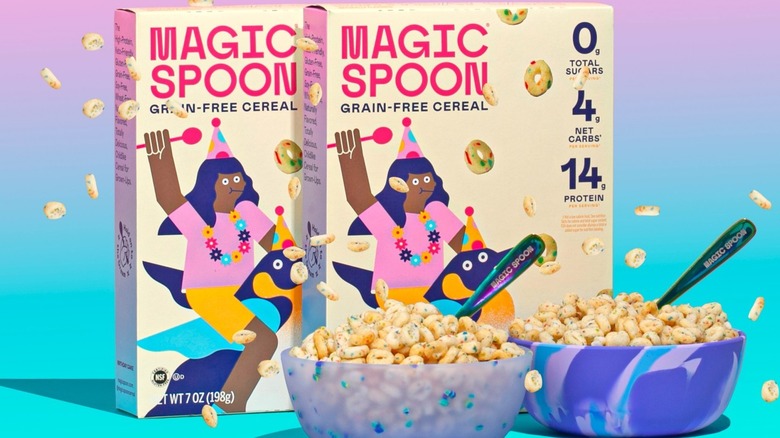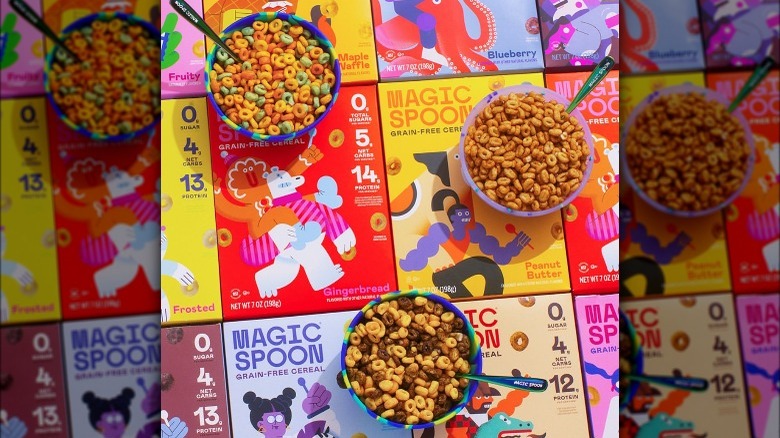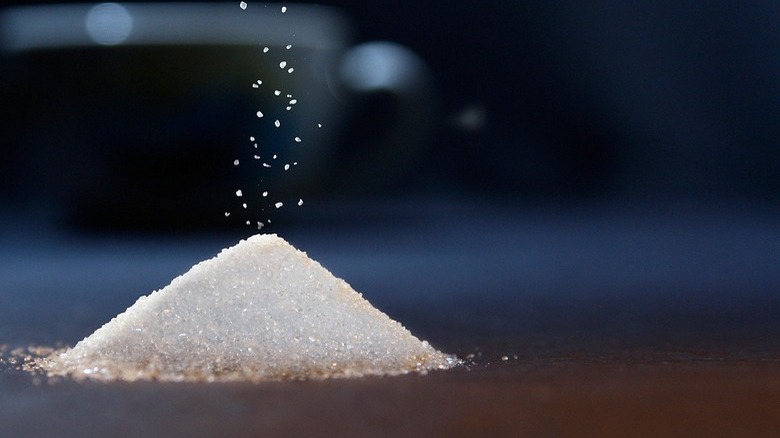The Secret Behind How Magic Spoon Tastes So Sweet
Do you suffer from an unrelenting sweet tooth? If you love to start your day with a sugary bowl of cereal, you're in good company. Peruse any supermarket cereal aisle, and you'll find a bevy of sucrose-ladened varieties coated in a sweet glaze, swimming alongside marshmallow shapes. Then, there are the chocolatey, fruity, or peanut buttery flavors that bear the unmistakable taste of glucose. Yes, nothing ushers in a promising day quite like an early morning sugar-high (or so it seems).
While you may suspect your beloved breakfast cereals of being less-than-nutritious, you may be shocked to learn just how much your bowl of flakes, o's, or pillowy squares has in common with a candy bar. For example, an Environmental Working Group study revealed that Kellogg's Honey Smacks, Malt-O-Meal's Golden Puffs, and Mom's Best Cereal's Honey-Ful Wheat are all "more than 50% sugar by weight." Statista echoes this bad news about Kellogg's Honey Smacks, adding that a comparison of 19 cereals manufactured by Kellogg's and Nestle/General Mills revealed that it had the most significant amounts of sugar. Meanwhile, Stacker looked at 50 breakfast cereals and found that the sugariest is Malt-O-Meal's Chocolate Marshmallow Mateys, boasting 147% more of the white stuff than most typical members of the cereal aisle.
Thankfully, manufacturers are increasingly offering cereals that are less riddled by sugar. One such product line is Magic Spoon. So, what does the company use in place of traditional processed sugar?
Magic Spoon is gluten-, grain-, and sugar-free
If you long for the flavor of your favorite childhood cereal but don't want all the processed sugars, excess gluten, and unpronounceable additives, you may be in luck. Magic Spoon Grain-Free Cereal promises to be exactly that. From the outset, Magic Spoon claims to be high-protein, low-carb, gluten- and grain-free, with only natural flavors, but what's of greater interest is its zero-sugar vow. Yes, "no cane sugar, corn syrup, are sugar alcohols" is the company's solemn pledge. So how does the company sweeten the sugary-sounding offerings, including maple waffle, cocoa, or cookies and cream? The Magic Spoon website claims to use a combination of monk fruit and allulose.
Back up a second. Allulose? What on earth is allulose? Well, according to the Cleveland Clinic, it is a sweetener recently approved by the FDA that is found in "figs, raisins, wheat, maple syrup, and molasses." Nutritionist Kristin Ciccolini told CNN, it is low on the glycemic index and doesn't affect blood sugars. Some artificial sweeteners have scary health risks. So, what risks are associated with allulose? The Cleveland Clinic warns that if you have too much, you may experience gastrointestinal issues including gas and bloating. (This shouldn't happen after one normal-sized bowl of cereal though. Phew.)
If you've ever been repulsed by the taste of other sweeteners, you're likely leery of anything that says it's a sugar replacement. After all, real sugar tastes pretty darn good. So, how does allulose taste?
Allulose isn't yet approved in several countries
When The New York Times posted a review of Magic Spoon cereal in April, many could relate to the outlet's portrayal of several artificial sweeteners. The Times' reviewer confessed to finding foods that use erythritol or stevia "vile" but added that they enjoyed "the taste and sweetness" of Magic Spoon. It apparently does not come with the "sharp tang or funky aftertaste" that's often associated with sugar-free foods. CNN's foray into the realm of Magic Spoon was equally promising. While they didn't mention the degree of sweetness, one may deduce that this was because it wasn't a problem. They did say the texture was a tad strange, but they loved the fact that this cereal kept them feeling satiated until their midday meal.
Allulose is approved by the FDA and has been referred to as "generally recognized as safe." It has also received approval in several other countries, including Mexico and Japan. It has not been approved in Canada or Europe, however, as they tend to have more stringent regulating systems, per the Cleveland Clinic. With this in mind, some may choose to consume this novel sweetener in moderation.
Finally, you don't have to raid your kids' cereal box. You can opt, instead, for a grown-up breakfast food that is just sweet enough to transport you back to the days of eating Froot Loops in front of the Saturday morning cartoons.


